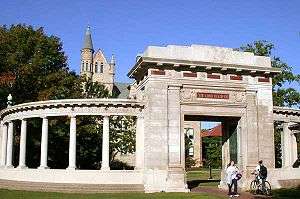Oberlin College
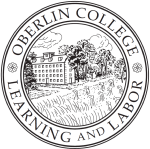 | |
Former names |
Oberlin Collegiate Institute (1833-1864) |
|---|---|
| Motto | Learning and Labor |
| Type |
Private Liberal Arts |
| Established | September 2, 1833 |
| Endowment | $832.4 million (2015)[1] |
| President | Marvin Krislov |
Administrative staff | 1,058 |
| Students | 2,900[2] |
| Location |
Oberlin, Ohio, USA 41°17′35″N 82°13′07″W / 41.292929°N 82.218576°WCoordinates: 41°17′35″N 82°13′07″W / 41.292929°N 82.218576°W |
| Campus | Suburban |
| Colors |
Cardinal red Mikado yellow |
| Athletics | NCAA Division III – NCAC |
| Nickname | Yeomen / Yeowomen |
| Affiliations | |
| Website | oberlin.edu |
Oberlin College is a private liberal arts college in Oberlin, Ohio. The college was founded as the Oberlin Collegiate Institute in 1835 by John Jay Shipherd and Philo Stewart. With its founding it is the oldest coeducational liberal arts college in the United States and the second oldest continuously operating coeducational institute of higher learning in the world. The Oberlin Conservatory of Music, part of the college, is the oldest continuously operating conservatory in the United States.
The College of Arts & Sciences offers more than 50 majors, minors, and concentrations. Oberlin is a member of the Great Lakes Colleges Association and the Five Colleges of Ohio consortium.
History
19th century

Both the college and the town of Oberlin were founded in northern Ohio in 1833 by a pair of Presbyterian ministers, John Jay Shipherd and Philo Stewart.[4] The College was built on 500 acres (2.0 km2) of land specifically donated by the previous owners, Titus Street, founder of Streetsboro, Ohio, and Samuel Hughes,[5] who lived in Connecticut. Shipherd and Stewert named their project after Jean-Frédéric Oberlin, an Alsatian minister whom they both admired. The ministers' vision was for both a religious community and school. Oberlin's founders bragged that "Oberlin is peculiar in that which is good," and the college has long been associated with progressive causes.

Asa Mahan (1799–1889) accepted the position as first President of the Oberlin Collegiate Institute in 1835, simultaneously serving as the chair of intellectual and moral philosophy and a professor of theology. Mahan's liberal views towards abolitionism and anti-slavery greatly influenced the philosophy of the newly founded college; likewise, only two years after its founding, the school began admitting students of all races, becoming the first college in the United States to do so.[6] The college had some difficult beginnings, and Rev. John Keep and William Dawes were sent to England to raise funds for the college in 1839–40.[7] A nondenominational seminary,[8] Oberlin's Graduate School of Theology (first called the Theological Department), was established alongside the college in 1833.[9] In 1965, the board of trustees voted to discontinue graduate instruction in theology at Oberlin, and in September 1966, six faculty members and 22 students merged with the Divinity School of Vanderbilt University.[9][10] Oberlin's role as an educator of African-American students prior to the Civil War and thereafter is historically significant.[11] In 1844, Oberlin College graduated its first black student, George B. Vashon,[12] who became one of the founding professors at Howard University[13] and the first black lawyer admitted to the Bar in New York State.

The African Americans of Oberlin and those attending Oberlin College "have experienced intense challenges and immense accomplishments since their joint founding in 1833. Its African American and other students of color have used education and activism to influence the college, the town, and beyond. Their efforts have helped Oberlin remain committed to its values of freedom, social justice, and service."[14] The College's approach to African Americans was by no means perfect. Intensely anti-slavery, Oberlin was the only college to admit black students in the 1830s. By the 1880s, however, with the fading of evangelical idealism, the school began segregating its black students.[15] Nonetheless, Oberlin graduates accounted for a significant percentage of African-American college graduates by the end of the 19th century. The college was listed as a National Historic Landmark on December 21, 1965, for its significance in admitting African Americans and women.[16] Oberlin is also the oldest coeducational institution in the United States, having admitted four women in 1837. These four women, who were the first to enter as full students, were Mary Kellogg (Fairchild), Mary Caroline Rudd, Mary Hosford, and Elizabeth Prall. All but Kellogg graduated. Mary Jane Patterson graduated in 1862 as the first black woman to earn a B.A. degree. Soon women were fully integrated into the college, and comprised from a third to half of the student body. The religious founders, especially evangelical theologian Charles Grandison Finney, saw women as inherently morally superior to men. Oberlin briefly stopped operating for seven months 1839 and 1840 due to lack of funds, making it the second oldest continuously operating coeducational liberal arts.[17]
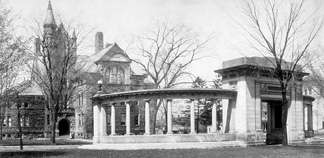
The faculty of Oberlin quarreled frequently with the highly religious president Mahan, and in 1850 voted unanimously to relieve him of his position as president. In his place, famed abolitionist and preacher Charles Grandison Finney (already a professor at the college since its founding) was made president, serving until 1866. Under Finney's leadership, Oberlin's faculty and students increased their activity in the abolitionist movement. They participated together with people of the town in biracial efforts to help fugitive slaves on the Underground Railroad (where Oberlin was a key stop), as well as to resist the Fugitive Slave Act.[18] One historian called Oberlin "the town that started the Civil War" due to its reputation as a hotbed of abolitionism.[19] In 1858, both students and faculty were involved in the controversial Oberlin-Wellington Rescue of a fugitive slave, which received national press coverage. Two participants in this raid, Lewis Sheridan Leary and John Anthony Copeland, along with another Oberlin resident, Shields Green, also participated in John Brown's Raid on Harpers Ferry. This heritage was commemorated on campus by the 1977 installation of sculptor Cameron Armstrong's "Underground Railroad Monument" (a railroad track rising from the ground toward the sky)[20] and monuments to the Oberlin-Wellington Rescue[21] and the Harper's Ferry Raid.[22]
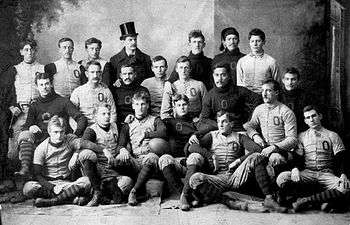
In 1866, James Fairchild became Oberlin's third president, and the first alumnus of the school to achieve that rank. Himself a committed abolitionist, Fairchild, at that point chair of theology and moral philosophy, played a role in Oberlin-Wellington Rescue, hiding fugitive slave John Price in his home. During Fairchild's tenure, the faculty and physical plant of the college expanded dramatically. In 1889, he resigned as president but remained as chair of systematic theology. (In 1896, Fairchild returned to the Oberlin leadership as acting President, serving until 1898.)[23]
Oberlin College was also prominent in sending Christian missionaries abroad. In 1881, students at Oberlin formed the Oberlin Band to journey as a group to remote Shanxi province in China. A total of 30 members of the Oberlin Band worked in Shanxi as missionaries over the next two decades. Ten died of disease, and in 1900, fifteen of the Oberlin missionaries, including wives and children, were killed by Boxers or Chinese government soldiers during the Boxer Rebellion.[24] The Oberlin Shansi Memorial Association, an independent foundation, was formed in their memory. The Association, with offices on campus, sponsors Oberlin graduates to teach in China, India, and Japan. It also hosts scholars and artists from Asia to spend time on the Oberlin campus.
20th century
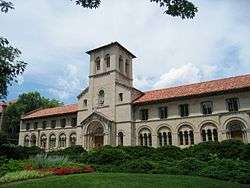
Henry Churchill King (1858–1934) became Oberlin's sixth president in 1902. At Oberlin from 1884 onward, he taught in mathematics, philosophy, and theology. Robert K. Carr served as Oberlin College president from 1960–1970, during a tumultuous period of student activism. Under his presidency, he increased the school's physical plant, with 15 new buildings completed. Under his leadership, student involvement in college affairs increased, with students serving on nearly all college committees as voting members (including the Board of Trustees). Despite these accomplishments, Carr clashed repeatedly with the students regarding issues related to the Vietnam War, and he left office in 1969 (with History professor Ellsworth C. Clayton taking over as acting President),[23] and was forced to resign as President in 1970.
Oberlin (and Princeton) alumnus Robert W. Fuller's[25] commitment to educational reform—which he had already demonstrated as a Trinity College dean—led his alma mater to make him its tenth president in November 1970. At age 33, Fuller became one of the youngest college presidents in U.S. history. During his Oberlin presidency—a turbulent time at Oberlin and in higher education generally—Fuller reshaped the student body by tripling the enrollment of minorities at the college. He also recruited and hired the first four African-American athletic coaches in a predominantly white American college or university, including Tommie Smith, the Gold Medalist sprinter from the 1968 Summer Olympics in Mexico City.
In 1970, Oberlin made the cover of Life as one of the first colleges in the country to have co-ed dormitories.[26][27] Fuller was eventually succeeded by the longtime Dean of the Conservatory Emil Danenberg, who served as President from 1975–1982, when he died in office.[23] In 1983, following a nationwide search, Oberlin hired S. Frederick Starr, an expert on Russian and Eurasian affairs, as well as a noted musician, as its 12th president. Starr's academic and musical accomplishments boded well for his stewardship of both the College and the Oberlin College Conservatory of Music.[28] However, despite increasing minority hiring,[28] Starr's tenure was marked by clashes with students over such issues as divestment from South Africa and the dismissal of a campus minister,[28] as well as Starr's general approach of reframing Oberlin as the "Harvard of the Midwest."[29] After a particularly vitriolic clash with students that took place on the front lawn of his home in April 1990,[29] Starr took a leave of absence as president from July 1991 – February 1992.[28] He officially resigned in March 1993, effective to June of that year.[28]
21st century
Nancy Dye became the 13th president of Oberlin College in July 1994,[30] succeeding the embattled Starr.[29] Oberlin's first female president, she oversaw the construction of new buildings, the increased selectiveness of the student body, and helped grow the endowment with the then-largest capital campaign in the college's history.[31] As president, Dye was known for her accessibility and inclusiveness. Especially in her first few years, she was a regular attendee at student events such as football games, concerts, and dorm parties.[29] Dye served as President for nearly 13 years, resigning on June 30, 2007.[32]
Oberlin's first and only hired trade union expert, Chris Howell, argues that the college engaged in "illegal" tactics to attempt to decertify its service workers' July 1999 vote to become members of United Automobile Workers union. Howell argues that college workers sought the union to represent them in response to the administration's effort to "speed up work" to meet a "mounting budget crisis".[33]
Karega controversy
In early 2016, Oberlin became the subject of a controversy when it was revealed that one of its professors, Joy Karega, had blamed Israel for the Charlie Hebdo attacks and for ISIS.[34] She also claimed that Jacob Rothschild and his family had financed both sides of every war since Napoleon.[35] She also wrote that Hurricane Sandy had been caused by people who had weaponized weather.[36] Several other professors stood up for her.[37] After five and a half months of discussion, the school removed her from her position,[38] and then fired her for the antisemitic statements in November 2016.[39]

Academics
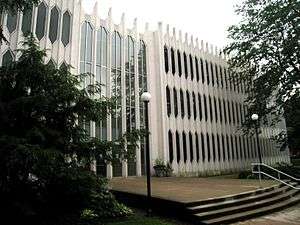
Of Oberlin's nearly 3,000 students, nearly 2,400 are enrolled in the College of Arts & Sciences, a little over 400 in the Conservatory of Music, and the remaining 180 or so in both College and Conservatory under the five-year Double-Degree program.[40]
The College of Arts & Sciences offers over 50 majors, minors, and concentrations.[41] Based on students graduating with a given major, its most popular majors over the last ten years have been (in order) English, Biology, History, Politics, and Environmental Studies. The College's science programs are considered strong, especially Biology, Chemistry and Physics. The college is home to the world's first undergraduate Neuroscience program.[42]
The Conservatory is located on the college campus. Conservatory admission is selective, with over 1400 applicants worldwide auditioning for 120 seats. There are 500 performances yearly, most free of charge, with concerts and recitals almost daily. The Conservatory was one of the recipients of the 2009 National Medal of Arts.[43] The Allen Memorial Art Museum, with over 13,000 holdings, was the first college art museum west of the Alleghenies.[44]
College Library
Oberlin College Library system is one of the largest undergraduate libraries in the nation. In addition to the main library there are branch libraries for art, music, and science, and a central storage facility. The libraries have large collections of print and media materials and provide access to an extensive array of online databases and journals. Beyond the 2.4 million-plus items available on campus, Oberlin students have access to more than 46 million volumes from over 85 Ohio institutions in through the OhioLINK consortium.[45] In addition to the breadth of its holdings, the Oberlin College Library is recognized for its quality: it received the Association of College and Research Libraries Excellence in Academic Libraries Award in 2002,[46] and in 2006 Director of Libraries Ray English was named the ACRL's Academic-Research Librarian of the Year.[47] In the summer of 2007 the main level of the main library was converted into an Academic Commons that provides integrated learning support and is a hub of both academic and social activity.[48]

OhioLINK consortium
Oberlin students and faculty benefit by Oberlin's membership in the OhioLINK consortium, providing access to 12,000+ commercially licensed online journals, 130 databases, 18,000+ ebooks and is rapidly growing digital media collections. The OhioLINK Central Catalog represents the library holdings of 87 libraries in the state, including the State Library of Ohio, plus the Center for Research Libraries. The collection is nearing 10 million unique records representing 27.5 million holdings in the system, and undergraduates account for the larger percentage of OhioLINK online borrowing – the process by which any enrolled student can readily request the loan of books and other items from any other library in the system.
Experimental College
The college's "Experimental College" or ExCo program, a student-run department, allows any student or interested person to teach their own class for a limited amount of college credit. ExCo classes by definition focus on material not covered by existing departments or faculty.[49][50]
Winter Term
Another aspect of Oberlin's academics is the Winter Term during the month of January. This term was created to allow students to do something outside the regular course offerings of the college. Students may work alone or in groups, either on or off campus, and may design their own project or pick from a list of projects and internships set up by the college each year. Students must complete a winter term project three years out of their four in the College of Arts and Sciences. Projects range from serious academic research with co-authorship in scientific journals, to humanitarian projects, to making avant-garde films about historic Chicago neighborhoods, to learning how to bartend. A full-credit project is suggested to involve five to six hours per weekday.[51]
Creativity and Leadership
The Creativity and Leadership Department is a recent addition to the Oberlin College experience. Created in 2005 as a part of the Northeast Ohio Collegiate Entrepreneurship Program (NEOCEP), a Kauffman Campuses Initiative, and sponsored by the Burton D. Morgan and Ewing Marion Kauffman, the department is focused on supporting and highlighting entrepreneurship within the student body.[52][53] This is done through a series of classes, symposia, Winter Term programs, grants, and fellowships available at no cost to current students and in some cases, recent alumni.[54] One such opportunity is the Creativity and Leadership Fellowship, a one-year fellowship for graduating seniors that includes a stipend of up to $30,000 dollars to advance an entrepreneurial venture.[55]
In 2012, the Creativity and Leadership department announced LaunchU,[56][57] a business accelerator open to Oberlin College students and alumni who are pursuing an entrepreneurial venture. The selective, three-week intensive program connects the participants with other entrepreneurs and business leaders chosen from the surround northeast Ohio region as well as the extensive Oberlin College alumni network. LaunchU culminates in a public pitch competition before a guest panel of investors, where the participants have the opportunity to be awarded up to $15,000 in funding. The winner of the 2014 LaunchU pitch competition was Chai Energy, a Los Angeles-based green energy startup focused on modernizing and personalizing home energy monitoring.[58][59][60] In 2014, LaunchU announced the creation of an online network in order to build stronger connections between entrepreneurs within the Oberlin College students and alumni network with a focus on attracting younger alumni.[61]
Campus culture

Political activism
Oberlin students have a reputation for being notably "'left-leaning'". Though the Princeton Review argues, "Some here worry 'Oberlin's student body is becoming more and more mainstream each year.'" The college was ranked among the Princeton Review's' list of "Colleges with a Conscience" in 2005.[62] In 2004, student activism led to a campus-wide ban on sales of Coca-Cola products.[63] However, this was revoked in spring 2014 and students may now buy Coca-Cola products from the student union.[64] In the 1960s, Memorial Arch became a rallying point for the College's civil rights activists and its anti-war movement. Oberlin supplied a disproportionate number of participants in Mississippi Freedom Summer, rebuilt the Antioch Missionary Baptist Church in the Carpenters for Christmas project, supported NAACP sponsored sit-ins in Cleveland to integrate the building-trades, and with the SCLC participated in demonstrations at Hammermill Paper. Emeritus Professor of Sociology (1966-2007), James Leo Walsh stated that students, "...carried out dozens of protests against the Vietnam war ranging from peaceful picketing to surrounding a local naval recruiters car", to the Oberlin Review in 1995.[65][66] In November 2002, 100 college workers students and faculty held a "mock funeral 'for the spirit of Oberlin'" in response to the administration's laying off 11 workers and reducing the work hours of five other workers without negotiation with college unions.[67] Oberlin Students have protested instances of fracking in Ohio such as "the first natural gas and fracturing industry conference in the state" in 2011.[68]
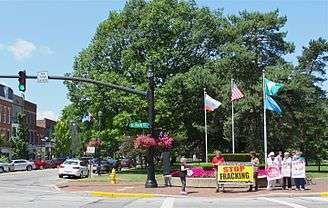
In 2013, after a string of racially biased postings on campus, president Marvin Krislov cancelled classes in response to student demands[69] and called for a day of reflection and change. In a public statement, he claimed that an investigation had identified two students believed to be largely responsible for the postings, who had been removed from campus.[70][71] In a police report of the events, two students, whose names have been redacted, admitted to some but not all of the offenses.[72]
During the fall 2014 semester, Oberlin's Student Labor Action Coalition organized a petition to permit dining hall temporary workers working four hour shifts to eat one meal from food the college throws out each day. The petition garnered over 1,000 signatures and resulted in workers obtaining the opportunity to put food into a management given styrofoam container to eat after their shifts.[73][74][75]
In May 2015, students temporarily took over their school's administration building to protest a $2,300 increase in tuition cost between the 2015 and 2016 academic school year.[76] Students initially proposed, "...moving from providing merit aid to need-based scholarships, loosening on-campus dining and housing requirements, reducing food waste and temporary workers in Campus Dining Services... " to the school's Vice President of Finance Mike Frandsen on Monday, April 27, 2015, in which their demands were declined for issue. $10,931,088 were allocated to management salaries for the 2013-2014 school year much of which came from student tuition.[77][78]
In December 2015, Oberlin's Black Student Union issued a series of 50 specific demands of the college and conservatory intending to eliminate, "...institutional complacency that allows violence against Black students to thrive and persist..." and restructure the curriculum "...to discuss blackness more in depth...". Such demands include promoting certain black faculty to tenured positions, hiring more black faculty, firing other faculty members, obtaining a $15 an hour minimum wage for all campus workers and guaranteed health care in their contracts. The board of trustees responded by appointing some of the individual faculty and by, "...reviewing the allocation of faculty positions with consideration of how they will contribute to interactional diversity in the curriculum..." in the college's 2016-2021 strategic plan.[79][80][81][82] The college opposes firing any employees in response and neglected to issue formal responses to many of the other demands though has sought to cut wages and health care funds for administrator, office worker and librarian Office and Professional Employees International Union members during contract negotiations.[83] Many campus workers still earn the minimum wage.[73] Over 75 students protested the college's attempt to alter administrator, office worker and librarian contracts during spring 2016 contract negotiations.[84]
LGBT advocacy
Oberlin is also known for its liberal attitude toward sexuality and gender expression. Oberlin was ranked among the 20 friendliest campuses for LGBT students in The Advocate's College Guide for LGBT Students.[85] Several different student groups exist to support the interests of LGBT students and their allies.
Student Cooperative Association
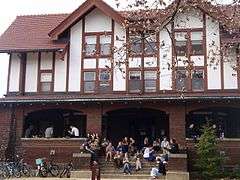
The Oberlin Student Cooperative Association, or OSCA, is a non-profit corporation that houses 174 students in four housing co-ops and feeds 594 students in eight dining co-ops. Its budget is more than $2 million, making it the third-largest of its kind in North America behind the Berkeley Student Cooperative and the Inter-Cooperative Council of Ann Arbor, and by far the largest relative to the size of the institution whose students it serves.
OSCA is entirely student-run, with all participating students working as cooks, buyers, administrators, and coordinators. Every member is required to do at least one hour per week of cleaning if they are able, encouraging accountability for the community and the space. Most decisions within OSCA are made by modified consensus. Oberlin bans all fraternities and sororities, making the co-ops the largest student-organized social system at the college. In addition to OSCA's four housing/dining and three dining-only cooperatives, Brown Bag Co-op is an OSCA-backed grocery that sells personal servings of food at bulk prices. OSCA also funds the Nicaragua Sister Partnership (NICSIS), a "sister cooperative" with Nicaragua's National Union of Farmers and Ranchers (UNAG). NICSIS works as a micro-lending program with a mission to empower female members of the community and provide superior benefits for laborers. Outside of OSCA, other Oberlin co-ops include the Bike Co-op, Pottery Co-op, and SWAP: The Oberlin Book Co-op.
Music
In addition to Oberlin Conservatory, Oberlin has musical opportunities available for amateur musicians and students in the college. Oberlin Steel, a steel pan ensemble founded in 1980, plays calypso/soca music from Trinidad and Tobago and has been performing at Oberlin's Commencement Illumination event for over 30 years. Oberlin College Taiko, founded in 2008, explores and shares Japanese taiko drumming as both a traditional and contemporary art form. The entirely student-run Oberlin College Marching Band (OCMB), founded in 1998, performs at various sporting events including football games, women's rugby, and pep rallies throughout the year. There are a number of a cappella groups, including the Obertones (all-male), Nothing But Treble (all-female), the Acapelicans (all-female), 'Round Midnight (co-ed, jazz/folk), Pitch, Please (co-ed), and Challah Cappella (co-ed, Jewish). Other notable music organizations include the Black Musicians Guild and the Arts and Sciences Orchestra. Students in the college can form chamber groups and receive coaching through the Conservatory. Student composers also provide a demand for musicians to perform their work.
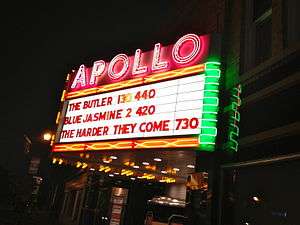
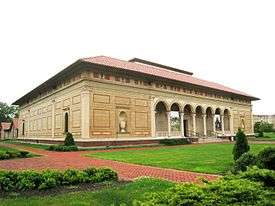
Film
Thomas Edison's moving picture show was shown in Oberlin in February 1900.[86] Just seven years later, Oberlin's Apollo Theater opened, and became one of the first theaters to install sound equipment, for the 1928 release of The Jazz Singer, the first "talkie." The theater has since been a mainstay in the Oberlin community at its comfortable locale on south campus, and in 2012 (after a year of renovations) became the centerpiece for The Danny DeVito and Rhea Perlman Cinema Studies Center for Media Education and Production. The area above the theatre includes editing labs, an animation area, a recording studio and small projection screening room.[87]
Art rental
Oberlin's museum has a unique art rental program. At the beginning of every semester students camp out in front of the north gate of the college's Allen Memorial Art Museum to get first pick of original etchings, lithographs and paintings by artists including Renoir, Warhol, Dalí, and Picasso. For five dollars per semester, students can hang these works on their dorm room walls. The program was started in the 1940s by Ellen H. Johnson, a professor of art at Oberlin, in order to "develop the aesthetic sensibilities of students and encourage ordered thinking and discrimination in other areas of their lives."[88]
Sexual Information Center
The school hosts a student-run Sexual Information Center, where students may receive free or heavily discounted condoms and lubricant, confidential peer counseling on sexual issues, and free rides to clinics in the area. The Sexual Information Center sponsored Safer Sex Night, originally started in the 1980s as a response to the AIDS crisis. The event was discontinued after the spring 2014 semester. Oberlin's Drag Ball Committee hosts Drag Ball, which marks Transgender Awareness week. Both these events are well-attended by students, although they have drawn criticism from conservatives.[89]
Campus speakers
A sampling of the school's past commencement speakers reflects its reputation for embracing diversity, ranging from Archbishop Desmond Tutu, Martin Luther King, Jr. and Jesse L. Jackson to figures as varied as Pete Seeger, Michelle Malkin, Robert Frost, Clarence Thomas, Adlai Stevenson and Michelle Obama.
International cooperation
On 26 August 2014, some students from Oberlin College went to BNU-HKBU United International College to be interns.[90]
Sustainability

Oberlin College has demonstrated its commitment to the pursuit of sustainability on a number of fronts. In 2006, Oberlin became one of the character institutions to sign the ACUPCC and set a target climate neutrality date for 2025.[91] Oberlin's innovative Adam Joseph Lewis Center For Environmental Studies, a building the Department of Energy labeled as one of the "milestone" buildings of the 20th century, incorporates a 4,600 square foot (425 square meter) photovoltaic array, the biggest of its kind in Ohio at the time. The AJLC also features a Living Machine, garden, orchard, and parking lot solar array.
The school utilizes biodiesel, hybrid, and electric vehicles for various purposes, offers financial support to a local transit company providing public transportation to the school, and has been home to the Oberlin Bike Co-op, a cooperatively run bicycle center, since 1986. Each residence hall monitors and displays real time and historic electricity and water use. Some dorms also have special lamps which display a color depending on how real time energy use compares to the average historic energy use. The school's Campus Committee on Shareholder Responsibility provides students, faculty, and staff with the opportunity to make suggestions and decisions on proxy votes.
In 2007, Oberlin received a grade of "B+" from the Sustainable Endowments Institute's annual College Sustainability Report Card, and was featured among schools as a "Campus Sustainability Leader".[92] In 2008, Oberlin received an "A-" on the annual College Sustainability Report Card.[93] It was also listed as the school with the greenest conscience by Plenty in their green campuses ratings.[94] In 2011, the College received an A on the Sustainability Report card.[95] Oberlin College participated in AASHE's Sustainability Tracking, Assessment, and Rating System (STARS) in early 2012. Oberlin College was one of only 43 institutions to receive a grade of Gold in STARS.[96]
According to a 2010 article in The Oberlin Review, renovated dorms may use more electricity.[97] This is the case for several dorms renovated during the summer of 2008.[97] The College architect, Steve Varelmann, has called the numbers "erratic and possibly unreliable."[97] According to Varelmann, a possible explanation for this phenomenon is that previously non-functioning equipment started functioning again after the renovation.[98] Students may also be at blame for their behavior: "What electronic devices are they using? Are they voluntarily reducing light usage? Are spaces experiencing increased use due to the improvements achieved from the renovation?"[99] John Scofield, professor of physics at Oberlin concluded that "We are building more and more efficient buildings, yet we're using more energy."[99]
Publications and media
Oberlin students publish a wide variety of periodicals. The college's largest publications are The Oberlin Review and The Grape. The Oberlin Review is a traditional weekly newspaper, focusing on current events, with a circulation of around 2,500. The Grape is Oberlin's student-run alternative newspaper. Fearless and Loathing is Oberlin's only online alternative publication, publishing news, opinions, creative non-fiction, and multimedia. There is also a newspaper pertaining to the interests of students of color, called In Solidarity.
Magazines on campus include Wilder Voice, a magazine for creative nonfiction and long-form journalism,[100] The Plum Creek Review, a literary review containing student-written fiction, poetry, translations, and visual art,[101] Headwaters Magazine, an environmental magazine,[102] and The Synapse, a science magazine.[103][104] Spiral is a magazine focused on genre fiction. The College also produces a quarterly alumni magazine,[105] while the Conservatory publishes its own magazine once a year.
The WOBC News Corps, a news division of WOBC-FM created in February 2010, produces local news segments that air bi-hourly. WOBC, a large student organization with significant non-student membership, also maintains an online blog that focuses on music and local events.
In February 2013, the college received a significant amount of press focusing on the so-called "No Trespass List," a secret list maintained by the college that bars individuals from campus without due process.[106] Student activists and members of the surrounding town joined together to form the One Town Campaign, which sought to challenge this policy.[107] On February 13, 2013, a forum at the Oberlin Public Library with over 200 people in attendance, including members of the college administration, the Oberlin city council and national press, saw speakers compare the atmosphere of the college to "a gated community."[108]
Athletics
The school's varsity sports teams are the Yeomen and Yeowomen. The name Yeomen arose in the early 1900s (decade) as a result of blending the former team moniker with the school's official motto. Early on in the program, football players and other athletes were known simply as Oberlin Men or "O" Men. Eventually, as the athletic department became more cohesive, the Yeomen mascot was adopted, drawing on the phonetic sound of "O" Men and the schools official motto of "Learning and Labor". As women's sports became more prevalent, "Yeowomen" was adopted to describe the mascot representing women's athletics. In 2014, the school announced that the albino squirrel will be its official mascot, although teams will continue to be referred to as "yeomen" and "yeowomen".[109]
Oberlin participates in the NCAA's Division III and the North Coast Athletic Conference (NCAC), a conference which includes Kenyon College, Denison University, Wooster College, Depauw University and others. Kenyon has traditionally been Oberlin's biggest rival. Recently, leaders of the Athletic Department and various club sports have spoken out in favor of increased institutional support for the teams, requesting that the College provide access to professional sports trainers and team transportation.[110] The college also hosts several private sports teams, including the Oberlin Ultimate team. Oberlin Ultimate was founded in 1976 and is often among the top 10 teams in its region.
Baseball
On Friday, May 8, 2015, the Oberlin baseball team won the championship of the NCAC. The championship was the first for Oberlin as a baseball team since it joined the NCAC in 1984.[111]
Football
Oberlin's football team was the first team coached by John Heisman, who led the team to a 7–0 record in 1892. Oberlin is the last college in Ohio to beat Ohio State (winning 7–6 in 1921). Though in modern times, the football team was more famous for losing streaks of 40 games (1992–1996) and 44 games (1997–2001), the Yeomen have enjoyed limited success in recent years.
Cheerleading
In 2011, Oberlin began its most recent attempt to feature a cheerleading squad. In 2006, a cheerleader fell from atop a pyramid at a football game, initiating the demise of Oberlin's Cheerleading Club. That injury prompted the school to restrict the club's activities, prohibiting stunting and tumbling, after which participation fizzled out. The club's charter, however, remained intact and was used to bring the squad back in 2011. Tryouts were held in the spring of 2011 and the cheerleading team went active at Oberlin's first home football game that Fall, a 42-0 win over Kenyon College. The squad also cheers for the basketball team and participates in spirit building and service events across campus and in the community.[112]
Ultimate
Oberlin has both men's and a women's Ultimate club teams, known as the Flying Horsecows and the Preying Manti[113] respectively. The Horsecows have made trips to College Nationals in 1992, 1995, 1997, and 1999. The Manti qualified for Nationals for the first time in 1997. Both teams qualified for Division III nationals in 2010. Both teams also maintain a tradition of emphasizing the spirit of Ultimate. After having an unsuccessful 2006–2007 season, the Flying Horsecows hired a coach to work them into shape, and succeeded in advancing to the Regional championship tournament.[114]
Notable people
Faculty
Alumni
See also
See also
- Mount Oberlin (Glacier National Park) — was named after the college.[115][116]
References
- ↑ As of June 30, 2015. "U.S. and Canadian Institutions Listed by Fiscal Year (FY) 2015 Endowment Market Value and Change in Endowment Market Value from FY 2014 to FY 2015" (PDF). National Association of College and University Business Officers and Commonfund Institute. 2016.
- ↑ url=http://www.oberlin.edu
- ↑ NAICU – Member Directory Archived November 9, 2015, at the Wayback Machine.
- ↑ Cityofoberlin.com
- ↑ Fletcher, Robert Samuel. A History of Oberlin College From Its Foundation Through the Civil War. Chicago: R.R. Donnelley & Sons Company, 1943. Print.
- ↑ Oberlin College Archives (2003-03-30). "Biography: Asa Mahan (1799-1889)". Retrieved 2008-03-27.
- ↑ The culture of English antislavery, 1780-1860. Retrieved 15 September 2014.
- ↑ "Oberlin College Archives - Published Resources - Architectural Records Guide - Group 11". Retrieved 28 June 2015.
- 1 2 "Oberlin College Archives - Published Resources - Womens History Guide - Group 11". Retrieved 28 June 2015. C1 control character in
|title=at position 55 (help) - ↑ "Oberlin College Archives - Holdings - Finding Guides - RG # - Name (bdate-ddate) - Biography/Administrative History". Retrieved 28 June 2015.
- ↑ "Constructing Black Education at Oberlin College". Retrieved 15 September 2014.
- ↑ http://blackamericanweb.com/?q=articles/news/the_black_diaspora_news/18489
- ↑ "Journal of Blacks in Higher Education". Retrieved 15 September 2014.
- ↑ African Americans at Oberlin, Then and Now Archived March 8, 2012, at the Wayback Machine.
- ↑ Cally L. Waite, "The Segregation of Black Students at Oberlin College after Reconstruction," History of Education Quarterly (2001) 41#3 pp 344-64. in JSTOR
- ↑ "National Historic Landmarks Program - Oberlin College". Retrieved 8 May 2007.
- ↑ Hoagland adds that this innovation as also advantageous for men because it would uplift them spiritually. Ronald W. Hogeland, "Coeducation of the Sexes at Oberlin College: A Study of Social Ideas in Mid-Nineteenth-Century America," Journal of Social History, (1972-73) 6#2 pp. 160-176 at p 161 in JSTOR
- ↑ Charles E. Hambrick-Stowe, Charles G. Finney and the Spirit of American Evangelicalism (1996) p 199
- ↑ Brandt, Nat (1990). The town that started the Civil War. Syracuse University Press. ISBN 0-8156-0243-X.
- ↑ Underground Railroad Monument
- ↑ "Oberlin-Wellington Rescue Monument". Retrieved 15 September 2014.
- ↑ "Harper's Ferry Memorial". Retrieved 15 September 2014.
- 1 2 3 "Presidents of Oberlin College". Oberlin College Archives. Oberlin College. Retrieved 21 October 2013.
- ↑ Brandt, Nat Massacre in Shansi, Syracuse: Syracuse University Press, 1994
- ↑ Robert K. and Olive Grabill Carr Papers, 1907-1981, Oberlin College Archives. Accessed Dec. 17, 2013.
- ↑ "College web site". Retrieved 15 September 2014.
- ↑ "Gender Policies". Retrieved 28 June 2015.
- 1 2 3 4 5 "2/12 - S. Frederick Starr (1940- )," Oberlin College website. Accessed Nov. 5, 2015.
- 1 2 3 4 Foss, Sara and Miller, Hanna. "Pomp and circumstances: Nancy Dye's first four years," Oberlin Review (May 22, 1998).
- ↑ "Presidents of Oberlin College". Oberlin College Archives. Retrieved Dec. 17, 2013.
- ↑ McIntyre, Mike, "Nancy Dye's Presidency," Oberlin Alumni Magazine vol. 97, #3 (Winter 2001).
- ↑ Kaplan, Maxine and Hansen, Jamie. "Dye Announces Retirement: After 12 Years, Dye is Set to Step Down," Oberlin Review (Sept. 15, 2006).
- ↑ P.15. Howell, Chris and Whelan, Megan. The Oberlin Review. vol. 123, no. 25. 26 May 1995.
- ↑ http://www.thetower.org/3012-oberlin-professor-claims-israel-was-behind-911-isis-charlie-hebdo-attack/
- ↑ http://www.thetower.org/3012-oberlin-professor-claims-israel-was-behind-911-isis-charlie-hebdo-attack/
- ↑ http://www.thetower.org/3036-3-more-totally-crazy-things-oberlin-professor-joy-karega-appears-to-believe/
- ↑ https://www.insidehighered.com/news/2016/04/12/oberlin-professors-condemn-colleagues-controversial-remarks-others-defend-them
- ↑ Colleen Flaherty (August 4, 2016). "Suspended for Anti-Semitism". Inside Higher Ed.
- ↑ Colleen Flaherty (November 16, 2016). "Oberlin Ousts Professor". Inside Higher Ed.
College fires Joy Karega, effective immediately, following an investigation into her anti-Semitic statements on social media
- ↑ "Applying to Oberlin: Double-Degree Program". Oberlin College. Retrieved 15 January 2013.
- ↑ "Academic Departments and Programs". Oberlin College. Retrieved 16 October 2014.
- ↑ "Sciences at Oberlin". Oberlin College. Retrieved 23 February 2014.
- ↑ "National Medal of Arts". Retrieved 28 June 2015.
- ↑ Short Tour: Allen Art Museum
- ↑ "Oberlin College Library". Retrieved 15 September 2014.
- ↑ "Excellence in Academic Libraries Award". Archived from the original on October 20, 2008. Retrieved October 20, 2008.
- ↑ "Ray English's Acceptance Speech". Archived from the original on October 20, 2008. Retrieved October 20, 2008.
- ↑ "Oberlin College Library". Retrieved 15 September 2014.
- ↑ "Fall 2002 Exco course listing". Retrieved 15 September 2014.
- ↑ "EXCO Committee". Retrieved 15 September 2014.
- ↑ "Office of Winter Term". Retrieved 15 September 2014.
- ↑ "Collegiate Entrepreneurship - The Burton D. Morgan Foundation". Retrieved 15 September 2014.
- ↑ "Oberlin College - Creativity and Leadership-About Us". Retrieved 15 September 2014.
- ↑ "How to Start a College Entrepreneurship Club - Inc.com". Inc.com. Retrieved 15 September 2014.
- ↑
- ↑ "Oberlin College LaunchU - Collaborate, Innovate, Accelerate". Oberlin College LaunchU. Retrieved 15 September 2014.
- ↑ "The Oberlin Review : launchu". Retrieved 15 September 2014.
- ↑ "About LaunchU - Oberlin College LaunchU". Oberlin College LaunchU. Retrieved 15 September 2014.
- ↑ "Chai Energy - LA Cleantech Incubator". Retrieved 15 September 2014.
- ↑ "Chaienergy.com - Chai Energy". Chaienergy.com. Retrieved 15 September 2014.
- ↑ "Members - Oberlin College LaunchU". Oberlin College LaunchU. Retrieved 15 September 2014.
- ↑ "Colleges with a conscience". Retrieved 15 September 2014.
- ↑ Taylor, Samantha (November 19, 2004). "College set to ban Coca-Cola". Oberlin Review (web link: Oberlin.edu)
- ↑ "College Lifts Ban on Coca-Cola Products".
- ↑ Merredith Collins and Melody R. Waller "Activism thrives through Oberlin's history" The Oberlin Review. 1 May 1995. Accessed May 6, 2015.
- ↑ "Oberlin College: James Leo Walsh. 2015. Accessed 6 May 2015.
- ↑ P1, 4, Decker, Rachel. "Unions Lampoon College" Oberlin Review vol. 131, no. 9, 15 November 2002
- ↑ Dickson, EJ, "Oberlin College students protest against fracking in Youngstown". Oberlin College and Conservatory: News and Media. 12 December 2011. Accessed 22 May 2015.
- ↑ "To the Oberlin Community". Retrieved 25 June 2013.
- ↑ "Oberlin Source: Building a Brilliant Future".
- ↑ "Oberlin president finds hateful messages 'personally upsetting' - Cleveland Jewish News: Local News".
- ↑ "Oberlin Police Department, Incident Report #13-00079" (PDF).
- 1 2 Bok, Oliver. "Temporary CDS Workers to Receive Free Meals" 12 December 2014. Oberlin Review. Accessed 25 May 2016.
- ↑ Sandrick, Bob."Oberlin College students protest meals, push for more diversity". 22 December 2013. Cleveland.com. Accessed 25 May 2016
- ↑ "Temporary CDS Workers to Receive Free Meals" 25 April 2015. Oberlin Review. Accessed 25 May 2016
- ↑ Payerchin, Richard. 1 May 2015 "Oberlin Students take over building to protest tuition hike" "The Morning Journal News"
- ↑ "Oberlin College: Staff Salaries" Chronicle Data. Accessed 6 May 2015
- ↑ Harris, Melissa, "Students Meet with Frandsen After Protests" . 1 May 2015. The Oberlin Review. Accessed May 6, 2015.
- ↑ "Oberlin College's ABUSUA (Black Student Union) Institutional Demands". Chronicle Telegram. 16 December 2015. Accessed 25 May 2016.
- ↑ "Oberlin College Strategic Plan 2016-2021"
- ↑ Krislov, Martin. "Response to Student Demands". 20 January 2016. Oberlin College and Conservatory
- ↑ Oberlin College and Conservatory Communications Staff. "5 Receive Tenure" 30 March 2016. Accessed 25 May 2015
- ↑ Bernstein, Jacob. "http://oberlinreview.org/10147/news/college-ocope-to-negotiate-april-12/ "College, OCOPE to Negotiate April 12" 8 April 2016. Accessed 25 May 2016
- ↑ Stocker, Madeline. "Students Rally as OCOPE Negotiations Continue". 25 May 2016. The Oberlin Review. Accessed May 25, 2016
- ↑ The Advocate College Guide for LGBT Students is the best ever road map to gay-friendly campuses. Even if we do say so ourselves.
- ↑ Blodgett, Geoffery. "The Early Apollo". Oberlin Online: News and Features. (web link: )
- ↑ Farkas, Karen (September 20, 2012). "Apollo Theatre in Oberlin reopens and includes new home for cinema studies department". Cleveland.Com". (web link: )
- ↑ Angell, Sue (September 26, 2005). "Art Rental Still Going Strong After 60 Years". Oberlin Online: News and Features. (web link: Oberlin.edu)
- ↑ Pearce, Jean (2003-11-05). "Radical Activist U: Oberlin College". FrontPageMag. Archived from the original on September 30, 2008. Retrieved 2008-10-02.
- ↑ UIC welcomes 20 international interns aboard
- ↑ "Carbon Neutrality". Retrieved 28 June 2015.
- ↑ "College Sustainability Report Card 2008". Sustainable Endowments Institute. Retrieved 15 September 2014.
- ↑ "College Sustainability Report Card 2009". Retrieved 15 September 2014.
- ↑ "Green Campuses 3.0". MNN - Mother Nature Network. Retrieved 15 September 2014.
- ↑ "Oberlin College - Green Report Card 2011". Retrieved 28 June 2015.
- ↑ "Oberlin College - Scorecard - Institutions - AASHE STARS". Retrieved 28 June 2015.
- 1 2 3 Rebecca Cable, Renovated Dorms May Use More Energy, The Oberlin Review, April 2010, p. 1.
- ↑ Rebecca Cable, Renovated Dorms May Use More Energy, The Oberlin Review, April 2010, p. 4.
- 1 2 Rebecca Cable, Renovated Dorms May Use More Energy, The Oberlin Review, April 2010, p. 4.
- ↑ "Wilder Voice". Retrieved 15 September 2014.
- ↑ "Plum Creek Review". Retrieved 15 September 2014.
- ↑ Headwaters Magazine
- ↑ "List of Oberlin College Student Groups". Retrieved 15 September 2014.
- ↑ "The Synapse Magazine". Retrieved 3 October 2014.
- ↑ "Oberlin.edu". Retrieved 15 September 2014.
- ↑ Associated Press, @ap (14 February 2013). "Oberlin: Students protest 'no trespass' list". WKYC. Retrieved 28 June 2015.
- ↑ http://www.nbcnews.com/id/50817568/#.US2RrBlyAfI. Retrieved February 27, 2013. Missing or empty
|title=(help) - ↑ "Secret 'No Trespass' list at Oberlin College raises concerns at forum". cleveland.com. Retrieved 28 June 2015.
- ↑ "Oberlin College Athletics - Oberlin is Going Nuts Over Its New Athletics Mascot". Oberlin College. Retrieved 15 September 2014.
- ↑ Karlgaard, Joe; et al. (2007-10-05). "Club Sports Demand Equal Attention". The Oberlin Review. Retrieved 2008-08-09.
- ↑ "Oberlin College Athletics - Baseball Wins NCAC Title for the First Time in School History". Oberlin College. Retrieved 28 June 2015.
- ↑ Perry, Nick. "Oberlin Cheerleading Club Revived". Fearless and Loathing. Retrieved 10 October 2011.
- ↑ "The Preying Manti". Retrieved 15 September 2014.
- ↑ UPA.org
- ↑ "Through The Years In Glacier National Park: An Administrative History (Appendix A)". National Park Service. Retrieved 2013-06-15.
- ↑ "Discovery and Exploration". National Park Service. Archived from the original on 2006-02-23. Retrieved 2007-01-12.
Further reading
- Barnard, John. From evangelicalism to progressivism at Oberlin College, 1866-1917 (The Ohio State University Press, 1969). full text online free
- Fletcher, Robert Samuel. A history of Oberlin College: From its foundation through the Civil War (Arno Press, 1971)
- Hogeland, Ronald W. "Coeducation of the Sexes at Oberlin College: A Study of Social Ideas in Mid-Nineteenth-Century America," Journal of Social History, (1972–73) 6#2 pp. 160–176 in JSTOR
- Morris, J. Brent. Oberlin, Hotbed of Abolitionism: College, Community, and the Fight for Freedom and Equality in Antebellum America. Chapel Hill, NC: University of North Carolina Press, 2014.
- Waite, Cally L. "The Segregation of Black Students at Oberlin College after Reconstruction," History of Education Quarterly (2001) 41#3 pp 344–64. in JSTOR
Primary sources
- Oberlin College. General Catalogue of Oberlin College, 1833-1908: Including an Account of the Principal Events in the History of the College, with Illustrations of the College Buildings (1909) Online
External links
| Wikimedia Commons has media related to Oberlin College. |
- Official website
- Official athletics website
- Oberwiki, the Oberlin wiki
-
 "Oberlin College". Encyclopedia Americana. 1920.
"Oberlin College". Encyclopedia Americana. 1920. -
 "Oberlin". Encyclopædia Britannica (11th ed.). 1911.
"Oberlin". Encyclopædia Britannica (11th ed.). 1911.
